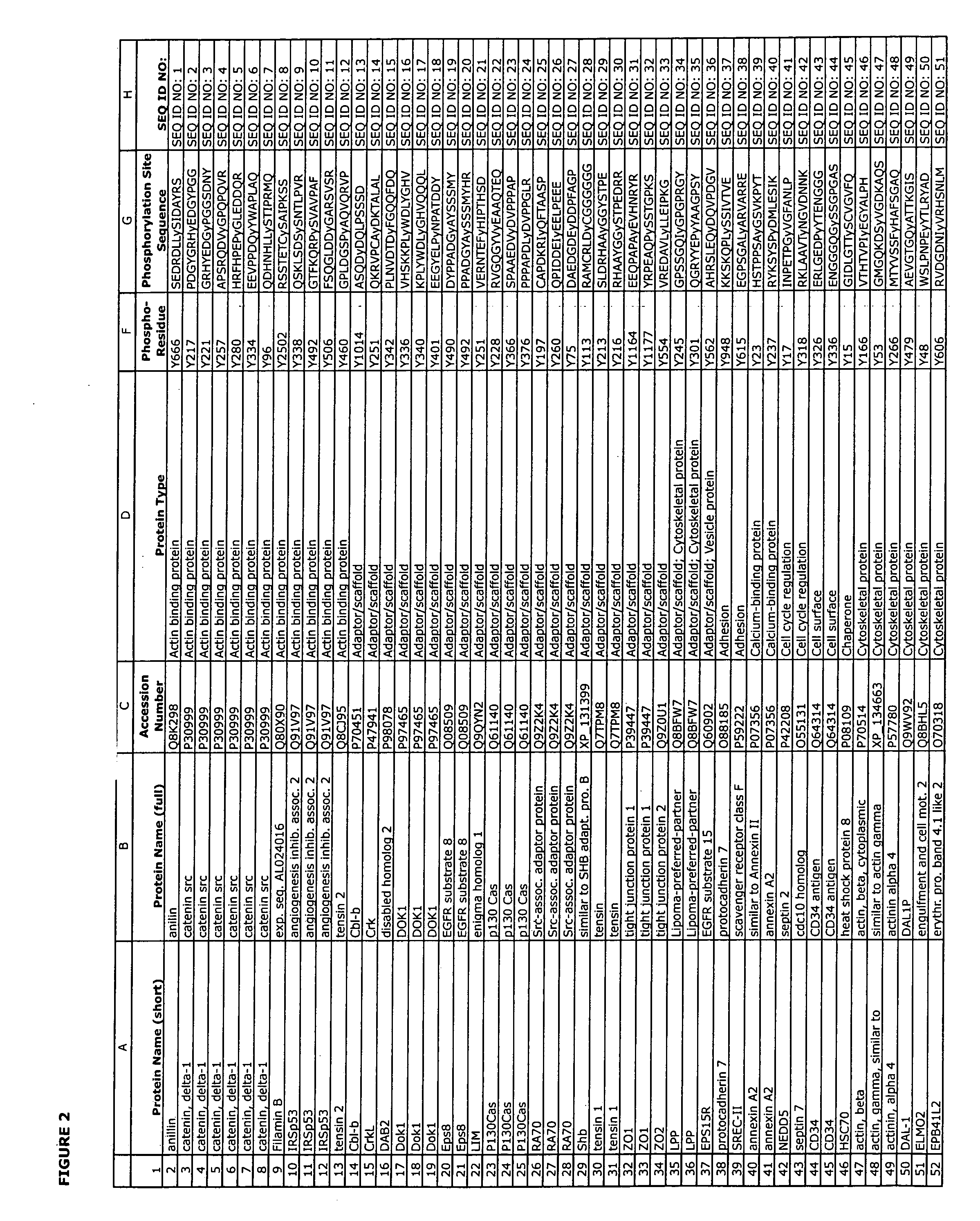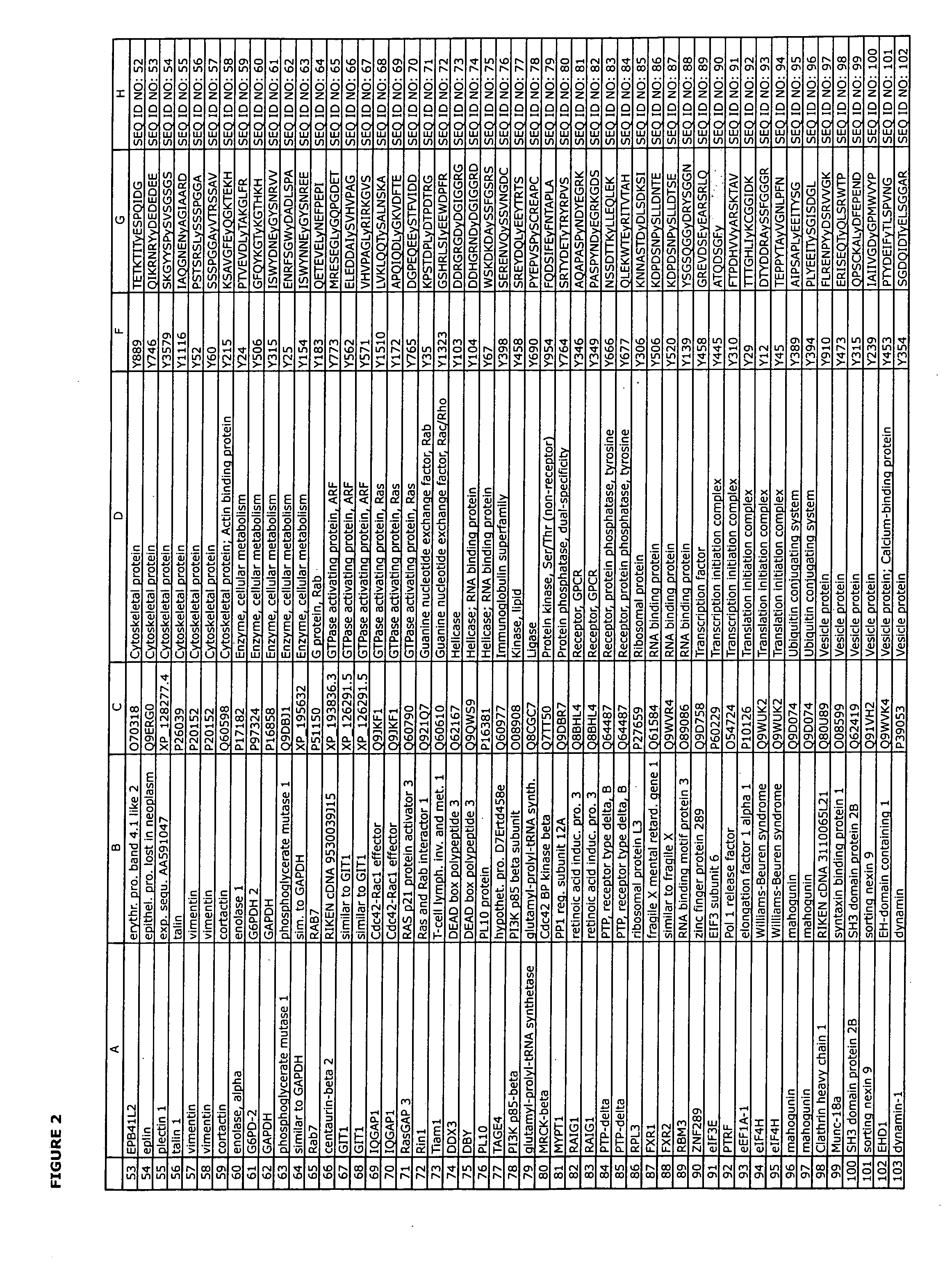Reagents for the detection of protein phosphorylation in c-Src signaling pathways
- Summary
- Abstract
- Description
- Claims
- Application Information
AI Technical Summary
Problems solved by technology
Method used
Image
Examples
example 1
Isolation of Phosphotyrosine-Containing Peptides from Extracts of Activated NIH / 3T3 Cells and Identification of Novel Phosphorylation Sites
[0143]In order to discover previously unknown c-Src-related signal transduction protein phosphorylation sites, IAP isolation techniques were employed to identify phosphotyrosine-containing peptides in cell extracts from NIH / 3T3 cells expressing an activated mutant form of c-Src kinase (Y527F). Increased c-Src activity has been demonstrated in a variety of human cancers, including breast, colon, pancreatic, ovarian, lung, esophogeal, and neural. See, e.g., Yeatman, supra. Thus, the c-Src activated 3T3 cell line was chosen to mimic signaling pathway activity in cancers involving activated c-Src.
[0144]Tryptic phosphotyrosine peptides were purified and analyzed from extracts of the 3T3 cell line as follows. Cells were cultured in DMEM medium supplemented with 10% bovine serum and penicillin / streptomycin under selection (1.5 μg / ml puromycin). Cells at...
example 2
Production of Phospho-specific Polyclonal Antibodies for the Detection of c-Src-related Signaling Protein Phosphorylation
[0154]Polyclonal antibodies that specifically bind a c-Src-related signal transduction protein only when phosphorylated at the respective phosphorylation site disclosed herein (see Table 1) are produced according to standard methods by first constructing a synthetic peptide antigen comprising the phosphorylation site sequence and then immunizing an animal to raise antibodies against the antigen, as further described below. Production of exemplary polyclonal antibodies is provided below.
A. Shb (tyrosine 113).
[0155]A 15 amino acid phospho-peptide antigen, RAMCRLDy*CGGGGGG (SEQ ID NO: 28) (where y*=phosphotyrosine), that corresponds to the tyrosine 113 phosphorylation site in human Shb protein (see Row 29 of Table 1), plus cysteine on the C-terminal for coupling, is constructed according to standard synthesis techniques using, e.g., a Rainin / Protein Technologies, Inc...
example 3
Production of Phospho-specific Monoclonal Antibodies for the Detection of c-Src-related Signaling Protein Phosphorylation
[0162]Monoclonal antibodies that specifically bind a c-Src-related signal transduction protein only when phosphorylated at the respective phosphorylation site disclosed herein (see Table 1) are produced according to standard methods by first constructing a synthetic peptide antigen comprising the phosphorylation site sequence and then immunizing an animal to raise antibodies against the antigen, and harvesting spleen cells from such animals to produce fusion hybridomas, as further described below. Production of exemplary monoclonal antibodies is provided below.
A. eIF4H (tyrosine 45).
[0163]A 15 amino acid phospho-peptide antigen, TEPPYTAy*VGNLPFN (SEQ ID NO: 94) (where y*=phosphotyrosine) that corresponds to the tyrosine 45 phosphorylation site in human eIF4H protein (see Row 95 of Table 1), plus cysteine on the C-terminal for coupling, is constructed according to ...
PUM
 Login to View More
Login to View More Abstract
Description
Claims
Application Information
 Login to View More
Login to View More - R&D
- Intellectual Property
- Life Sciences
- Materials
- Tech Scout
- Unparalleled Data Quality
- Higher Quality Content
- 60% Fewer Hallucinations
Browse by: Latest US Patents, China's latest patents, Technical Efficacy Thesaurus, Application Domain, Technology Topic, Popular Technical Reports.
© 2025 PatSnap. All rights reserved.Legal|Privacy policy|Modern Slavery Act Transparency Statement|Sitemap|About US| Contact US: help@patsnap.com



